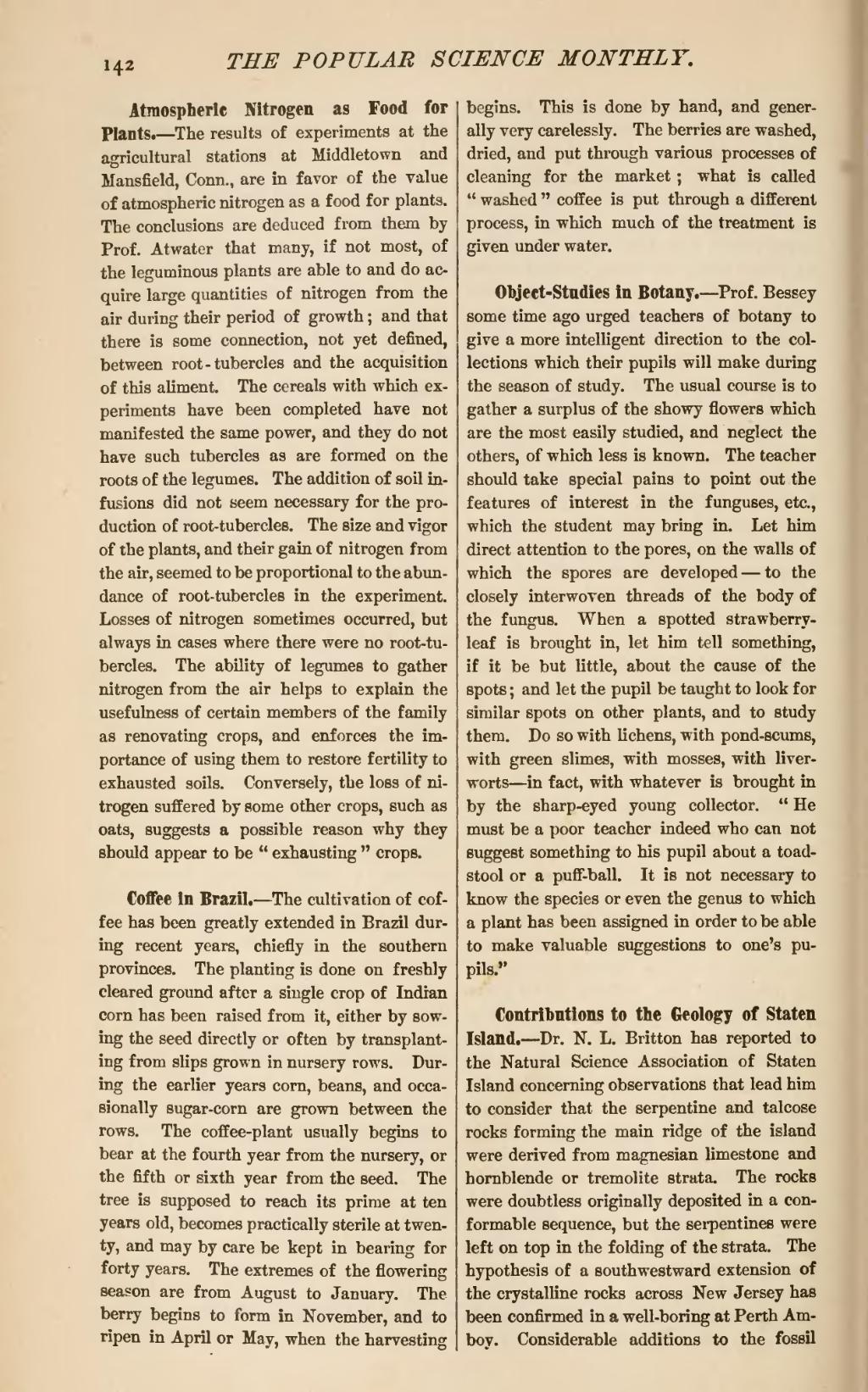Atmospheric Nitrogen as Food for Plants.—The results of experiments at the agricultural stations at Middletown and Mansfield, Conn., are in favor of the value of atmospheric nitrogen as a food for plants. The conclusions are deduced from them by Prof. Atwater that many, if not most, of the leguminous plants are able to and do acquire large quantities of nitrogen from the air during their period of growth; and that there is some connection, not yet defined, between root-tubercles and the acquisition of this aliment. The cereals with which experiments have been completed have not manifested the same power, and they do not have such tubercles as are formed on the roots of the legumes. The addition of soil infusions did not seem necessary for the production of root-tubercles. The size and vigor of the plants, and their gain of nitrogen from the air, seemed to be proportional to the abundance of root-tubercles in the experiment. Losses of nitrogen sometimes occurred, but always in cases where there were no root-tubercles. The ability of legumes to gather nitrogen from the air helps to explain the usefulness of certain members of the family as renovating crops, and enforces the importance of using them to restore fertility to exhausted soils. Conversely, the loss of nitrogen suffered by some other crops, such as oats, suggests a possible reason why they should appear to be "exhausting" crops.
Coffee in Brazil.—The cultivation of coffee has been greatly extended in Brazil during recent years, chiefly in the southern provinces. The planting is done on freshly cleared ground after a single crop of Indian corn has been raised from it, either by sowing the seed directly or often by transplanting from slips grown in nursery rows. During the earlier years corn, beans, and occasionally sugar-corn are grown between the rows. The coffee-plant usually begins to bear at the fourth year from the nursery, or the fifth or sixth year from the seed. The tree is supposed to reach its prime at ten years old, becomes practically sterile at twenty, and may by care be kept in bearing for forty years. The extremes of the flowering season are from August to January. The berry begins to form in November, and to ripen in April or May, when the harvesting begins. This is done by hand, and generally very carelessly. The berries are washed, dried, and put through various processes of cleaning for the market; what is called "washed" coffee is put through a different process, in which much of the treatment is given under water.
Object-Studies in Botany.—Prof. Bessey some time ago urged teachers of botany to give a more intelligent direction to the collections which their pupils will make during the season of study. The usual course is to gather a surplus of the showy flowers which are the most easily studied, and neglect the others, of which less is known. The teacher should take special pains to point out the features of interest in the funguses, etc., which the student may bring in. Let him direct attention to the pores, on the walls of which the spores are developed—to the closely interwoven threads of the body of the fungus. When a spotted strawberry leaf is brought in, let him tell something, if it be but little, about the cause of the spots; and let the pupil be taught to look for similar spots on other plants, and to study them. Do so with lichens, with pond-scums, with green slimes, with mosses, with liverworts—in fact, with whatever is brought in by the sharp-eyed young collector. "He must be a poor teacher indeed who can not suggest something to his pupil about a toadstool or a puff-ball. It is not necessary to know the species or even the genus to which a plant has been assigned in order to be able to make valuable suggestions to one's pupils."
Contributions to the Geology of Staten Island.—Dr. N. L. Britton has reported to the Natural Science Association of Staten Island concerning observations that lead him to consider that the serpentine and talcose rocks forming the main ridge of the island were derived from magnesian limestone and hornblende or tremolite strata. The rocks were doubtless originally deposited in a conformable sequence, but the serpentines were left on top in the folding of the strata. The hypothesis of a southwestward extension of the crystalline rocks across New Jersey has been confirmed in a well-boring at Perth Amboy. Considerable additions to the fossil

